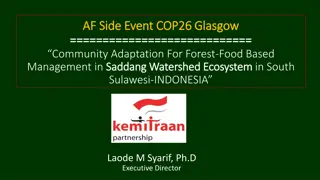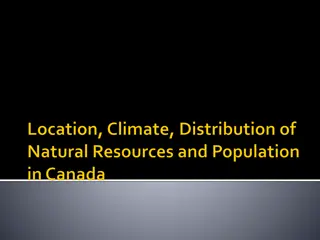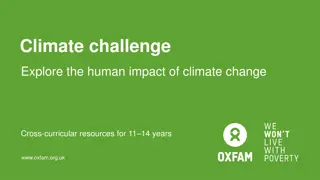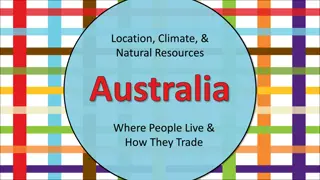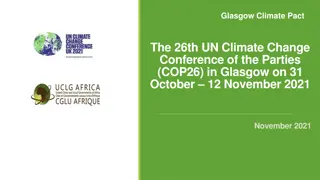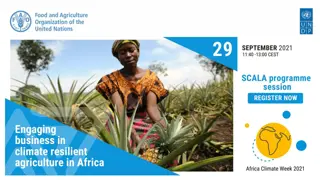Impact of Location, Climate, and Resources on Europe: Case Study of UK
The United Kingdom's location, climate, and natural resources significantly influence where people reside, their livelihoods, and trading activities. The UK, comprising Great Britain and Northern Ireland, benefits from a mild climate due to the Gulf Stream. Its diverse topography, from highlands to lowlands, provides vital resources like coal, oil, and natural gas. The discovery of large oil and gas reserves in the North Sea has boosted the UK's resource sector. Most Britons reside in urban areas, particularly London, a global trade and banking hub.
Download Presentation

Please find below an Image/Link to download the presentation.
The content on the website is provided AS IS for your information and personal use only. It may not be sold, licensed, or shared on other websites without obtaining consent from the author. Download presentation by click this link. If you encounter any issues during the download, it is possible that the publisher has removed the file from their server.
E N D
Presentation Transcript
The student will explain the impact of location, climate, natural resources, and population distribution on Europe. A. Compare how the location, climate, and natural resources of the United Kingdom and Russia affect where people live and how they trade. B. Compare how the location, climate, and natural resources of Germany and Italy affect where people live and how they trade.
The location of a country, its climate, and its natural resources have a tremendous impact on where its people live, how they make a living, and how they trade with other countries. The United Kingdom may be a small island nation, but it has had a tremendous impact on world history!
The UK consists of Great Britain (includes England, Scotland, and Wales) and Northern Ireland. Its capital is London, England. Although the UK is located very far north, a current of warm ocean water called the Gulf Stream flows by the British Isles and keeps temperatures mild.
The island of Great Britain has a jagged coastline with good harbors for trading vessels. Great Britain is divided into a highland zone (north and west) and a lowland zone (south and east). Important natural resources like coal, oil, and natural gas are found in the mountainous highland zone.
Large reserves of oil and natural gas found recently in the North Sea have made Great Britain a major supplier of those resources. Most Britons live in the lowland zone, where farming and England s major cities are located. Only about 1% of British people work in agriculture, and the country has to import about one-third of its food.
Most British citizens live in urban areas. The capital city of London, a world center for trade and banking, is located in the southern part of England. More than 7 million people live in London!
Many Britons work in service industries like banking, insurance, and tourism. Great Britain also has thriving manufacturing industries, including iron and steel production and electronics.
In contrast to the UK, Russia is the largest country in the world! Most citizens live in western Russia on the European Plain. This heartland is home to Russia s major cities, farms, grazing land for livestock, and the country s warmest temperatures.
Russia has a very cold climate, thanks to its location near the Arctic Ocean. Russia does not get a lot of rainfall, and only about 10% of Russia s total land is suitable for agriculture. Grains like wheat and barley are major crops. Russia imports a lot of its food, particularly meat.
Russia is rich in mineral resources, with huge deposits of coal, oil, and natural gas, and massive forests. Unfortunately, it is difficult and expensive to harvest and transport these resources because of the harsh climate and remote locations.
Many Russian goods are transported by railroad because rivers and major ports are blocked by ice in the winter. Russia s mining, manufacturing, and fishing industries are fueled by the country s natural resources.
Germany is a very prosperous nation, with one of the largest populations in Europe and the strongest economy. Germany truly owes much of its success to its location, climate, and natural resources! Germany enjoys a moderate climate with warm, mild summers and cool winters.
Extreme weather conditions do not occur very often. This mild climate is good for Germany s agriculture industry, which uses about half of Germany s land. Germany s location and geography yield many other benefits.
Although Germany produces many crops, manufacturing drives the country s economy. The Ruhr Valley in western Germany is the most densely populated area in the country, filled with factories, cities, and towns. Most Germans live in the cities and towns of western Germany.
Enormous deposits of coal and iron ore found in the Ruhr region fuel a huge manufacturing industry known for steel production, automobiles, building materials, and many other items. These manufacturing products are easily transported to the nearby Rhine River, Germany s major commercial waterway, and then on to the North Sea and Atlantic Ocean to trade with the world!
Italy attracts millions of tourists every year because of its spectacular scenery, beautiful weather, and fascinating history and culture. Italy enjoys a moderate climate with generally cool winters (colder in mountain regions) and warm summers.
Mountains cover about 70 % of the country. About two-thirds of Italians live in the northern part of the country, home to most of Italy s industry and agriculture. Because of their location close to central Europe, the industrial cities in northern Italy can trade easily with other European countries.
Grapes, often grown along mountainsides, are Italy s most valuable crop. Italian grapes have made Italy the largest wine producer in the world.
Italy has few mineral resources, and has to import most of its raw materials for industry. Tourism is the country s most important industry. Tourists flock to Italy to enjoy its climate and view ancient ruins and magnificent art from some of history s most famous artists like Leonardo da Vinci and Michelangelo.























